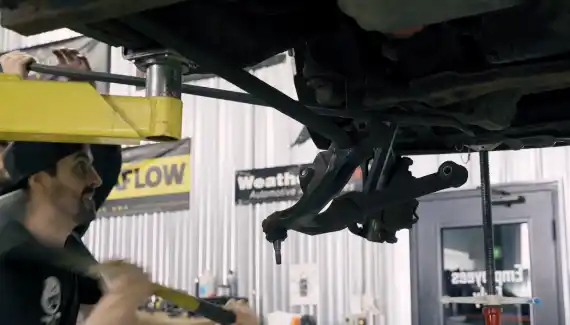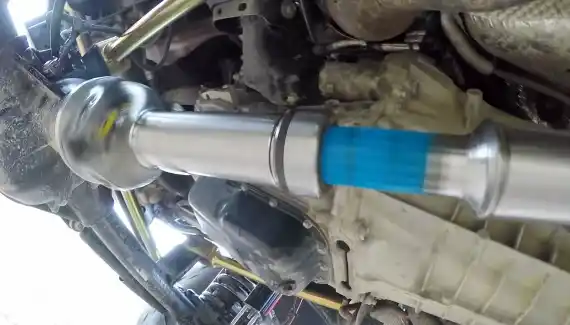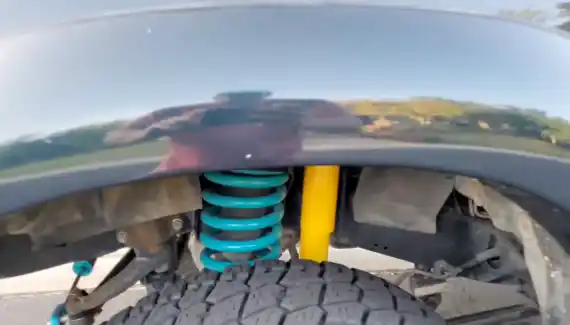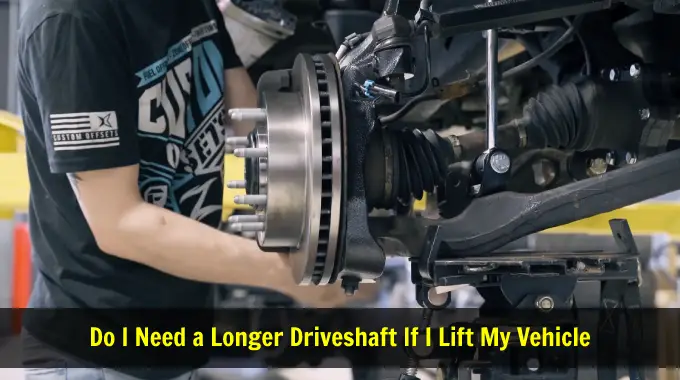Last Updated on May 7, 2023
Whether you’re increasing the size of your tires or going for a full body lift, it’s essential to consider how this might impact your drive shaft. Lifting any vehicle changes the angle of its driveshaft. So, don’t just go with the flow – consider if this new look is right for you.
From increased street presence to improved performance, modifying your car’s suspension by lifting it can yield several impressive benefits. Despite that, there are also some potential risks. There may be limitations in CV joints or misaligned drivetrain angles.
Unearthing the mysteries behind lifting vehicles, we will explore why you need a longer driveshaft and everything you should know before taking the plunge.
Why Do I Need a Longer Driveshaft If I Lift My Vehicle: 8 Reasons

Most people lift their vehicles to get better ground clearance and more off-road capability, but upgrading to a longer driveshaft is also necessary after lifting your ride.
Not only does this improve suspension travel, but it also helps prevent driveline issues like separation or quick wear. The following are reasons to replace your driveshaft if you lift your vehicle:
Changes In Drivetrain Angles
When your vehicle is lifted, the angle of the drivetrain changes due to increased suspension travel. This can cause vibrations, binding, and premature wear on components such as the CV joints. Installing a longer driveshaft with an angle that matches the new transfer case or differential position can reduce these risks.
This helps to ensure that power is delivered efficiently without causing any additional stress on components like bearings or universal joints.
Increased Risk of Separation
When you lift your vehicle, there is an increased risk that the driveshaft will split at the slip joint or pull at the transfer case due to added suspension travel. A long driveshaft can help keep all components separate during operation by allowing enough suspension travel.
Besides that, having two universal joints rather than one can further reduce any potential separation issues caused by lift kits or other modifications.
Suspension Changes
Because lifts often require changes to existing suspension parts like shocks or shackles, it’s likely that you’ll also need a longer driveshaft when installing them. A longer driveshaft will give you more flexibility if you want to adjust the ride height or add aftermarket equipment like fender flares or winches.
Moreover, having enough length for greater suspension travel can also help absorb bumps in rough terrain without damaging any vital components in the drivetrain system.
More Suspension Travel
After you install an aftermarket suspension, your factory-length rear drive shaft may not be able to handle that extra movement and maintain its proper angle. You’ll need a longer driveshaft for an appropriate amount of torque to still be transmitted without any problems.
CV Joint Limitations
As mentioned above, CV joints connect your drivetrain components together while allowing them some degree of flexibility. However, if you lift your vehicle over 3 inches or so, then that degree of flexibility may not be enough, and a replacement with universal joints is needed.
A new longer driveshaft helps provide more space between moving parts, allowing for smoother turns and better overall performance.
The Case of Taller Tires

Whenever larger tires are added onto vehicles, especially when lifted, don’t forget to account for their added weight when selecting a new driveline angle. Because taller tires typically require increased torque capacity from the driveline itself to get them moving properly.
In most cases, installing a longer driveshaft will solve this issue without needing any mods to other parts of your system as long as everything is balanced first.
Improved Performance
Driving enthusiasts and performance-hungry lifted vehicle owners can get a boost of power by installing longer drive shafts. Extended driveshafts create higher torque output from your engine, improve maneuverability, and reduce vibration for a smoother ride.
Also, your truck will be ready for any modification efforts you plan to do afterward. And with increased flexibility and range of motion, further adjustments and balancing processes required to complete the installation process can be made in no time.
For More Off-road Use
Getting a long driveshaft is especially important if you plan on taking your lifted truck off-road more frequently. This type of usage tends to strain and misalign components due to increased levels of articulation between parts caused by natural environment obstacles like rocks or creeks.
A longer shaft can handle these conditions much better than its shorter counterpart and help prevent any damage from occurring in the process.
How Can You Tell If You Need a Longer Driveshaft After Lifting?
After lifting your vehicle, it may be necessary to switch up the driveshaft for improved performance. Knowing how to recognize warning signs is important to ensure your car maintains optimal function and take swift action if problems arise.
These following signs mean you need a new driveshaft:
Clunking or Banging Noise
One of the first things you should look out for is any clunking or banging noise coming from underneath your vehicle. It could be an indication that your driveshaft is too short and needs to be replaced with a longer one to accommodate the lift.
Difficulty Shifting Gears

If you are having difficulty shifting gears or your transmission slips, it could be because of a misaligned drive shaft due to its shortened length after lifting. If left unresolved, this could lead to severe damage, so it’s best to get it checked immediately by an experienced mechanic.
Increased U-Joint Wear
Another sign that you may need a longer driveshaft is increased wear on the U-joints of your driveshaft. Having a short driveshaft puts extra pressure on these components and causes them to wear faster than they should. This can lead to expensive repairs down the road.
Driveshaft Binding
You may also experience binding of the driveshaft when turning if your lift has caused it to become too short for its application. This will cause an uncomfortable feeling while driving as well as potential damage down the line if left unresolved for too long.
Excessive Vibration
Excessive vibration coming from underneath your vehicle is another symptom of needing a longer driveshaft after lifting. This could be caused by either an uneven weight distribution or misalignment due to its shortened length.
Unusual Handling or Steering
An additional symptom that a longer driveshaft is needed is if you experience unusual handling or steering issues when driving. If this happens, it could mean that something’s wrong with your drivetrain.
Transmission or Differential Damage
After lifting, the most common symptom of a short drive shaft is transmission or differential damage from excessive stress put on these components. This type of damage can easily snowball into much more expensive repairs if not taken care of immediately.
Can the Stock Driveshaft Be Modified to Work With a Lifted Vehicle?

Modifying the stock driveshaft on a lifted vehicle is not recommended, as it could lead to dangerous consequences. For example, increased wear and tear on the components, alignment problems that could lead to premature failure, etc.
If you are looking to install a lifted vehicle, replacing or upgrading your stock driveshaft with an aftermarket version is highly recommended. An aftermarket rear shaft designed for lifted vehicles uses higher-quality materials to handle the added load when driven in a lift configuration.
Aside from that, aftermarket long driveshafts offer improved strength and reliability over their stock counterparts.
For a Lifted Vehicle, How Long Does a Drive Shaft Last?
There are a lot of factors that affect how long a lifted vehicle’s drive shaft lasts. The overall quality of the shaft and its components will affect its durability significantly, as will the type of terrain it is exposed to.
It is also essential to consider any additional weight that may be added to the vehicle due to larger wheels, tires, or other modifications. Generally speaking, a properly maintained drive shaft in a lifted vehicle can last anywhere from 50,000 miles up to 100,000 miles.
Factors such as regular maintenance and the use of high-quality components can extend this range further. Body lift kit installation instructions must be followed correctly, and an experienced mechanic must inspect all parts regularly.
Also, replacing worn components before they fail can help maximize the life expectancy of the drive shaft.
When a Vehicle Is Lifted, Does the Drive Shaft Affect the Transmission?
A lifted vehicle’s drive shaft does affect the transmission. This is because the drive shaft links the transmission and the rear axle, transferring the turning motion generated by the transmission to the axle.
If a vehicle is lifted, this can cause strain on the universal joints of the drive shaft, leading to wear and tear over time. This can lead to the misalignment of components, potentially damaging or decreasing the performance of both the transmission and axle.
To prevent this from happening, proper suspension lift kits must be installed when lifting a vehicle. These kits will ensure that all components remain correctly aligned and that proper lubrication is supplied to ensure smooth operation between components.
Is a Heavier Driver Shaft Better For a Lifted Car?

A heavier driveshaft is not necessarily better for a lifted car. Generally speaking, the lighter the driveshaft, the better it is for a lifted vehicle because less rotating mass means more power and better acceleration response at the wheels.
Additionally, lighter-weight driveshafts are easier to install and reduce stress on components such as U-joints and yokes. You might want a heavier, stronger driveshaft for off-roading or extreme conditions since it can take more abuse than a lighter one.
Heavier driveshafts are also beneficial for vehicles with larger tires that require more torque to spin them. But it takes more power to spin those heavier driveshafts, resulting in a decrease in performance.
Ultimately, when choosing a driveshaft for your lifted truck, you need to weigh the pros and cons of each option. Think about the terrain you’ll be driving on and whether you’ll need the extra strength of a heavier model or can get away with a lighter one.
Upgrade Performance and Safety with an Extended Driveshaft
Upgrading your car with a lift kit can feel like you’ve taken it to the next level, but not understanding all of its implications could lead to some nasty surprises. Adding extra components, like an extended driveshaft, will make your vehicle perform better and safer if you lift it.
When you’re considering modifications for your vehicle, consider how changing the body lift height, transmission type, and axle length can all require an extended drive shaft. If ever unsure of what’s best for your particular car or truck, don’t hesitate to ask a qualified mechanic who will gladly provide advice.
